Effects of Current Filaments on IGBT Avalanche Robustness: A Simulation Study
Abstract
:1. Introduction
2. Avalanche Breakdown Characteristics of FS-IGBT
2.1. Mechanism of Negative Differential Resistance Branching
2.2. The Impact of αpnp
2.3. The Impact of Temperature
3. Properties of the Current Filament
3.1. Structural Model and Simulation Method
3.2. Physical Mechanisms for Controlling the Strength of Current Filament
3.3. Physical Mechanisms for Driving the Movement of Current Filament
4. Conclusions
Author Contributions
Funding
Data Availability Statement
Conflicts of Interest
References
- Baburske, R.; Lutz, J.; Heinze, B. Effects of Negative Differential Resistance in High Power Devices and Some Relations to DMOS Structures. In Proceedings of the 2010 IEEE International Reliability Physics Symposium, Garden Grove, CA, USA, 2–6 May 2010; IEEE: Garden Grove, CA, USA, 2010; pp. 162–169. [Google Scholar]
- Lutz, J.; Baburske, R. Dynamic Avalanche in Bipolar Power Devices. Microelectron. Reliab. 2012, 52, 475–481. [Google Scholar] [CrossRef]
- Hower, P.L.; Krishna Reddi, V.G. Avalanche Injection and Second Breakdown in Transistors. IEEE Trans. Electron Devices 1970, 17, 320–335. [Google Scholar] [CrossRef]
- Baburske, R.; Niedernostheide, F.-J.; Lutz, J.; Schulze, H.-J.; Falck, E.; Bauer, J.G. Cathode-Side Current Filaments in High-Voltage Power Diodes Beyond the SOA Limit. IEEE Trans. Electron Devices 2013, 60, 2308–2317. [Google Scholar] [CrossRef]
- Oetjen, J.; Jungblut, R.; Kuhlmann, U.; Arkenau, J.; Sittig, R. Current lamentation in Bipolar Power Devices during Dynamic Avalanche Breakdown. Solid-State Electron. 2000, 44, 117–123. [Google Scholar] [CrossRef]
- Toechterle, C.; Pfirsch, F.; Sandow, C.; Wachutka, G. Analysis of the Latch-up Process and Current Filamentation in High-Voltage Trench-IGBT Cell Arrays. In Proceedings of the 2013 International Conference on Simulation of Semiconductor Processes and Devices (SISPAD), Glasgow, UK, 3–5 September 2013; IEEE: Glasgow, UK, 2013; pp. 296–299. [Google Scholar]
- Suwa, T. 2D-TCAD Simulation Study of Capture Layer and Repellent Layer of Current Filament in Trench-Gate IGBTs. In Proceedings of the 2021 International Conference on Simulation of Semiconductor Processes and Devices (SISPAD), Dallas, TX, USA, 27–29 September 2021; IEEE: Dallas, TX, USA, 2021; pp. 32–35. [Google Scholar]
- Endo, K.; Nagamine, S.; Saito, W.; Matsudai, T.; Ogura, T.; Setoya, T.; Nakamae, K. Direct Photo Emission Motion Observation of Current Filaments in the IGBT under Avalanche Breakdown Condition. In Proceedings of the 2016 28th International Symposium on Power Semiconductor Devices and ICs (ISPSD), Prague, Czech Republic, 12–16 June 2016; IEEE: Prague, Czech Republic, 2016; pp. 367–370. [Google Scholar]
- Bhojani, R.; Kowalsky, J.; Lutz, J.; Kendig, D.; Baburske, R.; Schulze, H.-J.; Niedernostheide, F.-J. Observation of Current Filaments in IGBTs with Thermoreflectance Microscopy. In Proceedings of the 2018 IEEE 30th International Symposium on Power Semiconductor Devices and ICs (ISPSD), Chicago, IL, USA, 13–17 May 2018; IEEE: Chicago, IL, USA, 2018; pp. 164–167. [Google Scholar]
- Toechterle, C.; Pfirsch, F.; Sandow, C.; Wachutka, G. Evolution of Current Filaments Limiting the Safe-Operating Area of High-Voltage Trench-IGBTs. In Proceedings of the 2014 IEEE 26th International Symposium on Power Semiconductor Devices & IC’s (ISPSD), Waikoloa, HI, USA, 15–19 June 2014; IEEE: Waikoloa, HI, USA, 2014; pp. 135–138. [Google Scholar]
- Muller-Dauch, A.; Pfirsch, F.; Pfaffenlehner, M.; Silber, D. Source Side Thermal Runaway of Trench IGBTs, Dependence on Design Aspects. In Proceedings of the 2006 IEEE International Symposium on Power Semiconductor Devices & IC’s, Naples, Italy, 4–8 June 2006; IEEE: Naples, Italy, 2006; pp. 1–4. [Google Scholar]
- Tanaka, M.; Abe, N.; Nakagawa, A. Impact of 3D Simulation on the Analysis of Unclamped Inductive Switching. Jpn. J. Appl. Phys. 2020, 59, SGGD01. [Google Scholar] [CrossRef]
- Egawa, H. Avalanche Characteristics and Failure Mechanism of High Voltage Diodes. IEEE Trans. Electron Devices 1966, ED-13, 754–758. [Google Scholar] [CrossRef]
- Lutz, J.; Baburske, R.; Chen, M.; Heinze, B.; Domeij, M.; Felsl, H.-P.; Schulze, H.-J. The nn+Junction as the Key to Improved Ruggedness and Soft Recovery of Power Diodes. IEEE Trans. Electron Devices 2009, 56, 2825–2832. [Google Scholar] [CrossRef]
- Domeij, M.; Lutz, J.; Silber, D. On the Destruction Limit of Si Power Diodes during Reverse Recovery with Dynamic Avalanche. IEEE Trans. Electron Devices 2003, 50, 486–493. [Google Scholar] [CrossRef]
- Heinze, H.P.F. Influence of Buffer Structures on Static and Dynamic Ruggedness of High Voltage FWDs. In Proceedings of the ISPSD ’05. The 17th International Symposium on Power Semiconductor Devices and ICs, Santa Barbara, CA, USA, 23–26 May 2005; IEEE: Santa Barbara, CA, USA, 2005; pp. 215–218. [Google Scholar]
- Knipper, U.; Wachutka, G.; Pfirsch, F.; Raker, T.; Niedermeyr, J. Time-Periodic Avalanche Breakdown at the Edge Termination of Power Devices. In Proceedings of the 2008 20th International Symposium on Power Semiconductor Devices and IC’s, Orlando, FL, USA, 18–22 May 2008; IEEE: Orlando, FL, USA, 2008; pp. 307–310. [Google Scholar]
- Lophitis, N.; Antoniou, M.; Udrea, F.; Wikstrom, T.; Nistor, I. Turn-off Failure Mechanism in Large Area IGCTs. In Proceedings of the CAS 2011 Proceedings (2011 International Semiconductor Conference), Sinaia, Romania, 17–19 October 2011; IEEE: Sinaia, Romania, 2011; pp. 361–364. [Google Scholar]
- Spirito, P.; Breglio, G.; Irace, A.; Maresca, L.; Napoli, E.; Riccio, M. Physics of the Negative Resistance in the Avalanche I – V Curve of Field Stop IGBTs: Collector Design Rules for Improved Ruggedness. IEEE Trans. Electron Devices 2014, 61, 1457–1463. [Google Scholar] [CrossRef]
- Baliga, B.J. Analytical Modeling of IGBTs: Challenges and Solutions. IEEE Trans. Electron Devices 2013, 60, 535–543. [Google Scholar] [CrossRef]
- Andreas Muller, F.P. Trench IGBT Behaviour near to Latch-up Conditions. In Proceedings of the Proceedings. ISPSD ’05. The 17th International Symposium on Power Semiconductor Devices and ICs, Santa Barbara, CA, USA, 23–26 May 2005; IEEE: Santa Barbara, CA, USA, 2005; pp. 255–258. [Google Scholar]
- Wang, C.; Zhang, L. Peak Electric Field Shifting Induced by Avalanche Injection under Static Avalanche in High Voltage Diode. IEICE Electron. Express 2017, 14, 20170627. [Google Scholar] [CrossRef]
- Baliga, B.J. Fundamentals of Power Semiconductor Devices; Springer: New York, NY, USA, 2008; ISBN 978-0-387-47313-0. [Google Scholar]
- Breglio, G.; Irace, A.; Napoli, E.; Riccio, M.; Spirito, P. Experimental Detection and Numerical Validation of Different Failure Mechanisms in IGBTs During Unclamped Inductive Switching. IEEE Trans. Electron Devices 2013, 60, 563–570. [Google Scholar] [CrossRef]
- Knipper, U.; Pfirsch, F.; Raker, T.; Niedermeyr, J.; Wachutka, G. Destruction in the Active Part of an IGBT Chip Caused by Avalanche-Breakdown at the Edge Termination Structure. In Proceedings of the 2008 International Conference on Advanced Semiconductor Devices and Microsystems, Smolenice, Slovakia, 12–16 October 2008; IEEE: Smolenice, Slovakia, 2008; pp. 159–162. [Google Scholar]
- Felsl, H.P.; Falck, E.; Niedernostheide, F.-J.; Milady, S.; Silber, D.; Lutz, J. Electro-Thermal Simulation of Current Filamentation in 3.3-kV p+-n−-n+ Diodes with Differenth Edge Terminations. In Proceedings of the 2006 IEEE International Symposium on Power Semiconductor Devices & IC’s, Naples, Italy, 4–8 June 2006; IEEE: Naples, Italy, 2006; pp. 1–4. [Google Scholar]
- Niedernostheide, F.-J.; Falck, E.; Schulze, H.-J.; Kellner-Werdehausen, U. Influence of Joule Heating on Current Filaments Induced by Avalanche Injection. IEE Proc. Circuits Devices Syst. 2006, 153, 3. [Google Scholar] [CrossRef]
- Tong, X.; Liu, S.; Sun, W.; Wu, J. Complete Avalanche Process and Failure Mechanism of Trench-Gate FS-IGBT Under Unclamped Inductive Switching by Using Infrared Visualization Method. IEEE Trans. Electron Devices 2020, 67, 3908–3911. [Google Scholar] [CrossRef]
- Riccio, M.; Irace, A.; Breglio, G.; Spirito, P.; Napoli, E.; Mizuno, Y. Electro-Thermal Instability in Multi-Cellular Trench-IGBTs in Avalanche Condition: Experiments and Simulations. In Proceedings of the 2011 IEEE 23rd International Symposium on Power Semiconductor Devices and ICs, San Diego, CA, USA, 23–26 May 2011; IEEE: San Diego, CA, USA, 2011; pp. 124–127. [Google Scholar]
- Endo, K.; Nakamae, K. Temporally- and Spatially-Resolved Observations of Current Filament Dynamics in Insulated Gate Bipolar Transistor Chip During Avalanche Breakdown. IEEE Trans. Device Mater. Relib. 2019, 19, 723–727. [Google Scholar] [CrossRef]
- Shankar, B.; Zeng, K.; Gunning, B.; Martinez, R.P.; Meng, C.; Flicker, J.; Binder, A.; Dickerson, J.R.; Kaplar, R.; Chowdhury, S. Movement of Current Filaments and Its Impact on Avalanche Robustness in Vertical GaN P-N Diode Under UIS Stress. In Proceedings of the 2022 Device Research Conference (DRC), Columbus, OH, USA, 26 June 2022; IEEE: Columbus, OH, USA, 2022; pp. 1–2. [Google Scholar]
- Shiba, Y.; Omura, I.; Tsukuda, M. IGBT Avalanche Current Filamentaion Ratio: Precise Simulations on Mesh and Structure Effect. In Proceedings of the 2016 28th International Symposium on Power Semiconductor Devices and ICs (ISPSD), Prague, Czech Republic, 12–16 June 2016; IEEE: Prague, Czech Republic, 2016; pp. 339–342. [Google Scholar]
- Watanabe, M.; Shigyo, N.; Hoshii, T.; Furukawa, K.; Kakushima, K.; Satoh, K.; Matsudai, T.; Saraya, T.; Takakura, T.; Itou, K.; et al. Impact of Three-Dimensional Current Flow on Accurate TCAD Simulation for Trench-Gate IGBTs. In Proceedings of the 2019 31st International Symposium on Power Semiconductor Devices and ICs (ISPSD), Shanghai, China, 19–23 May 2019; IEEE: Shanghai, China, 2019; pp. 311–314. [Google Scholar]
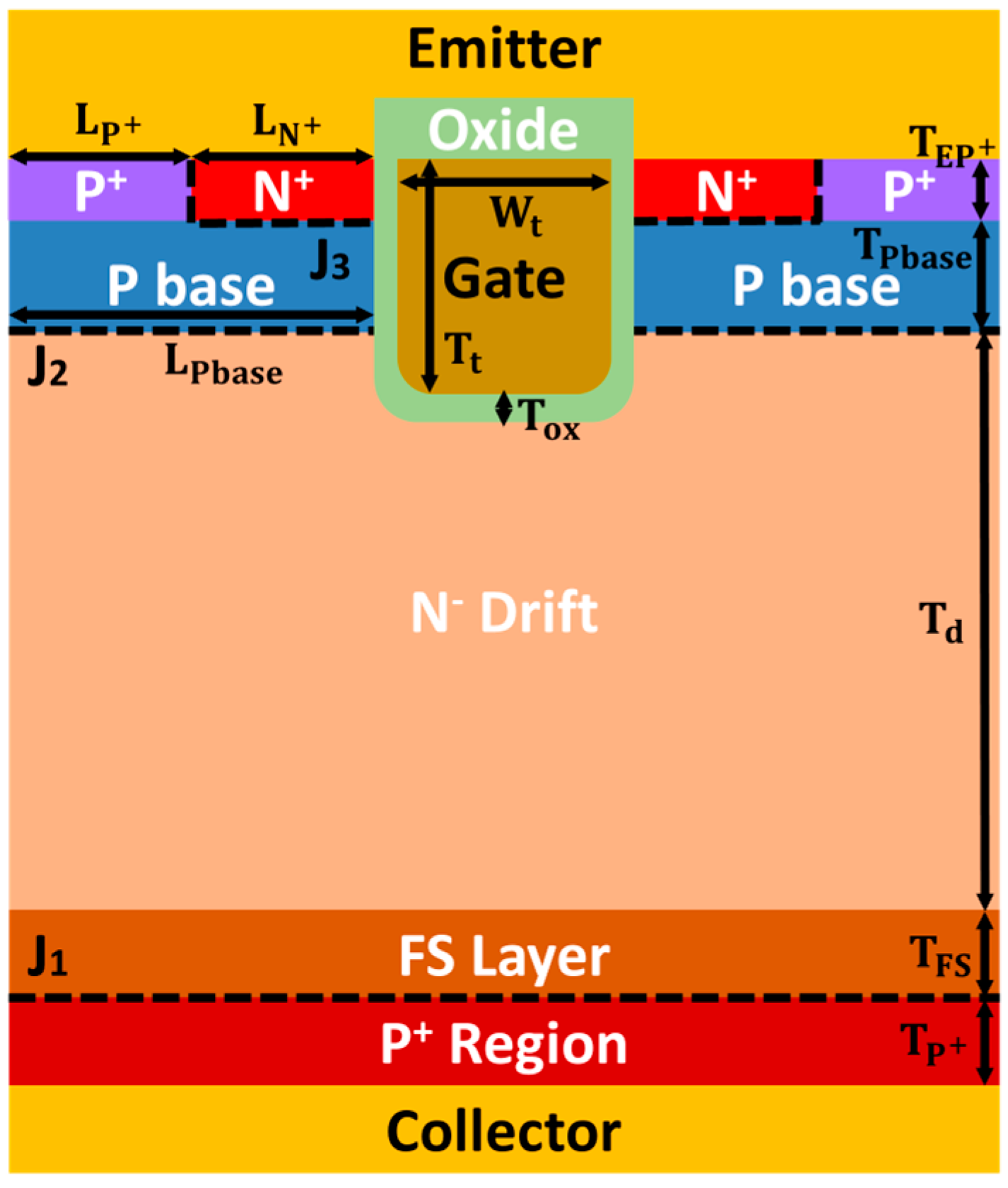
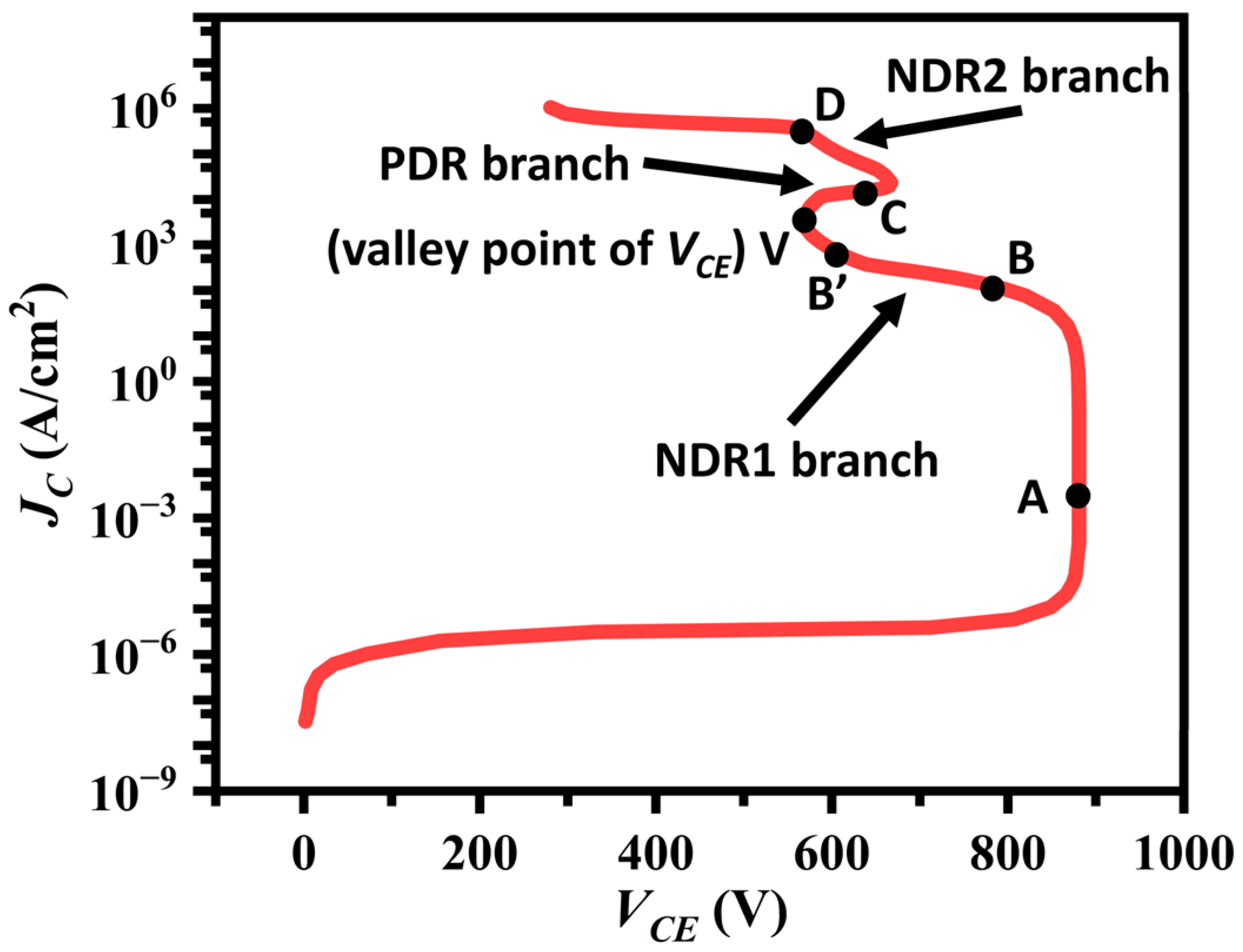
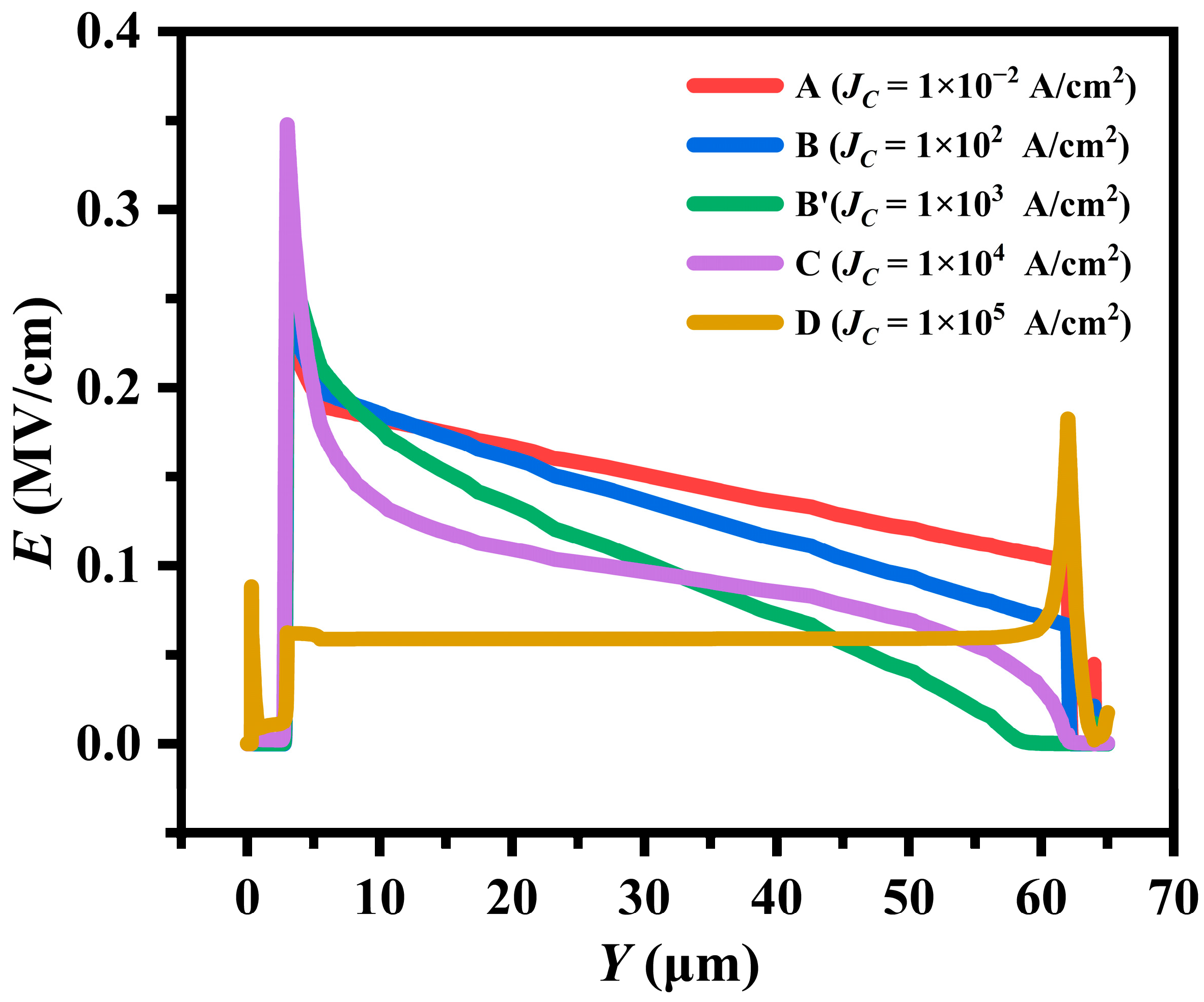
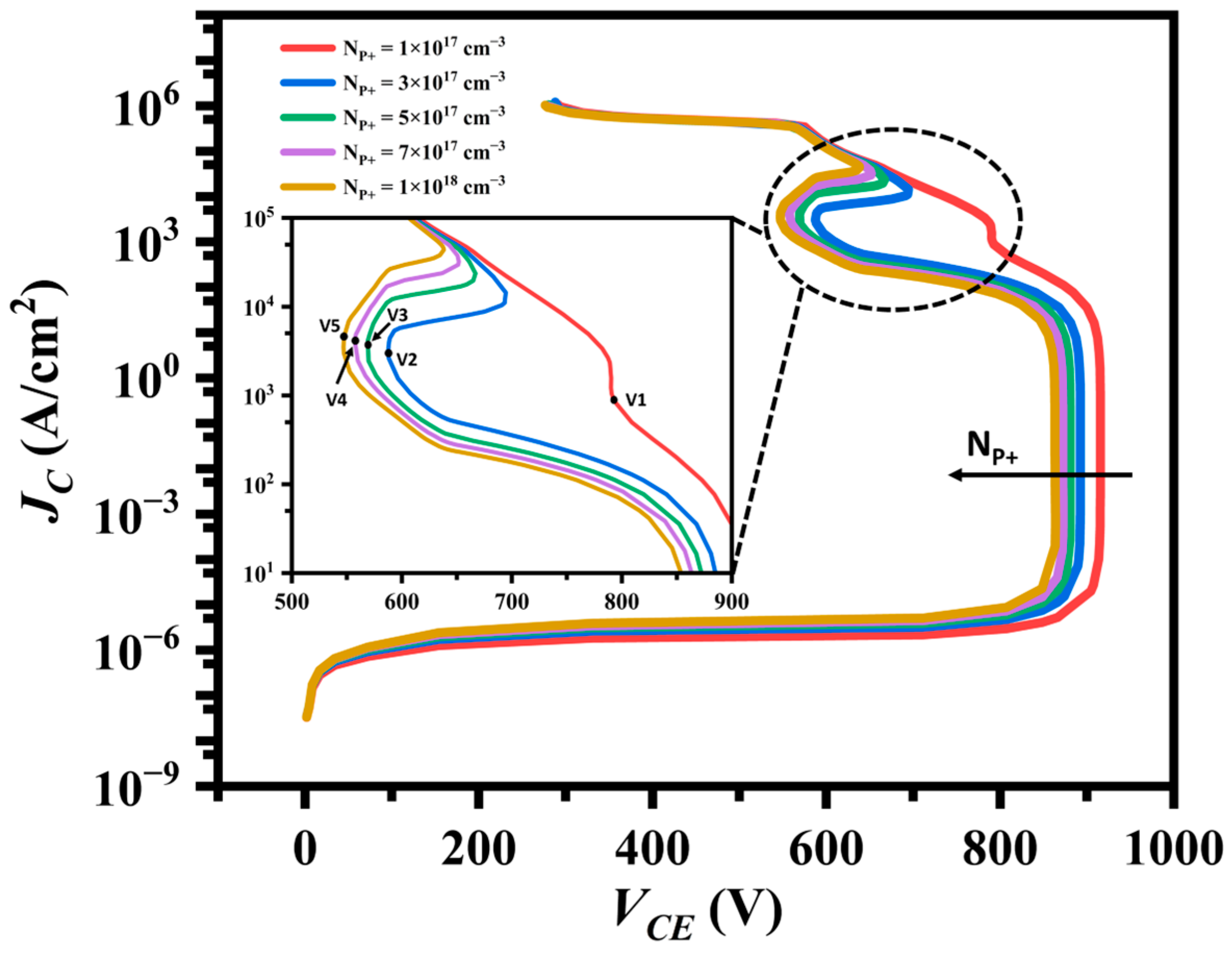
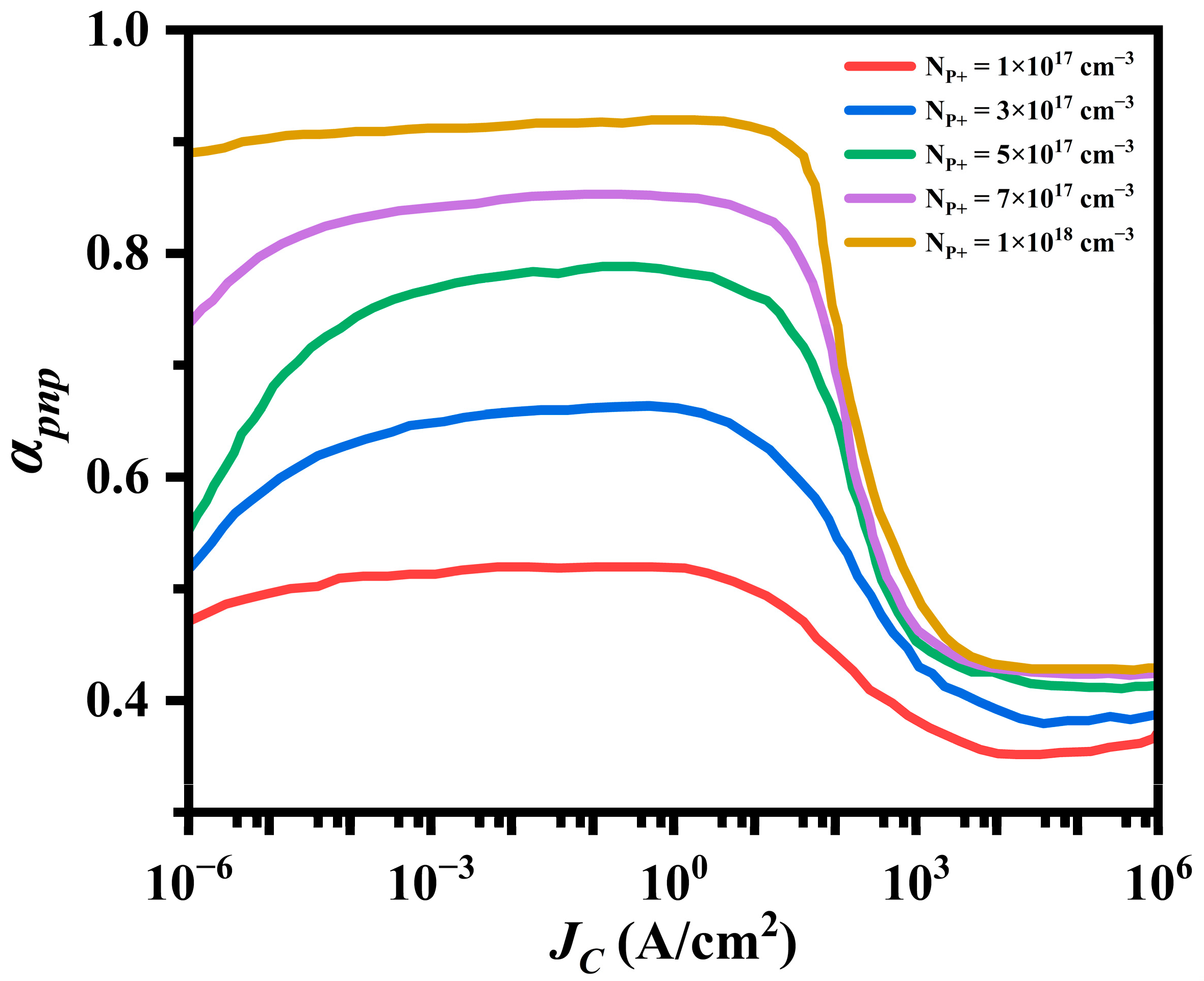

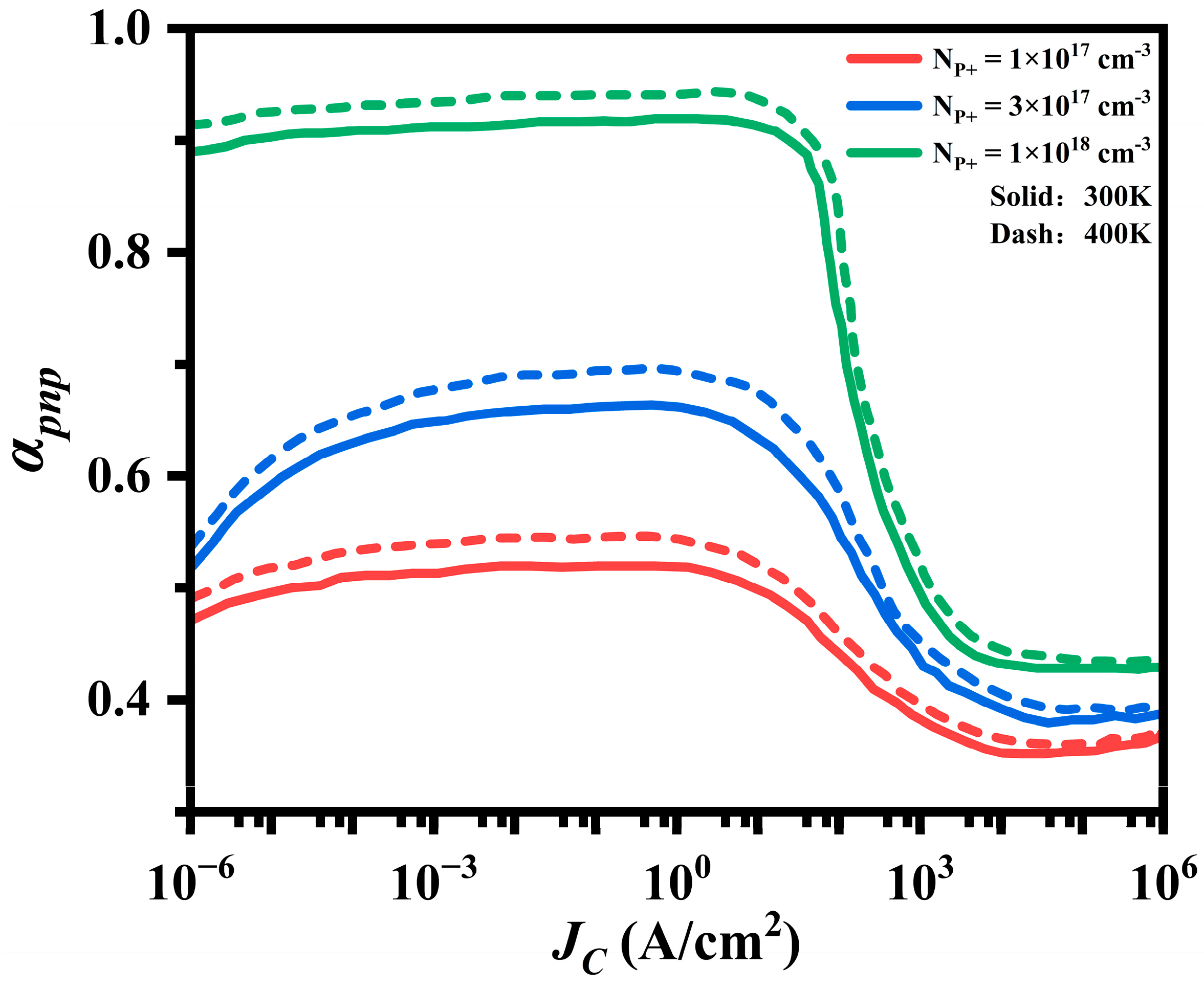
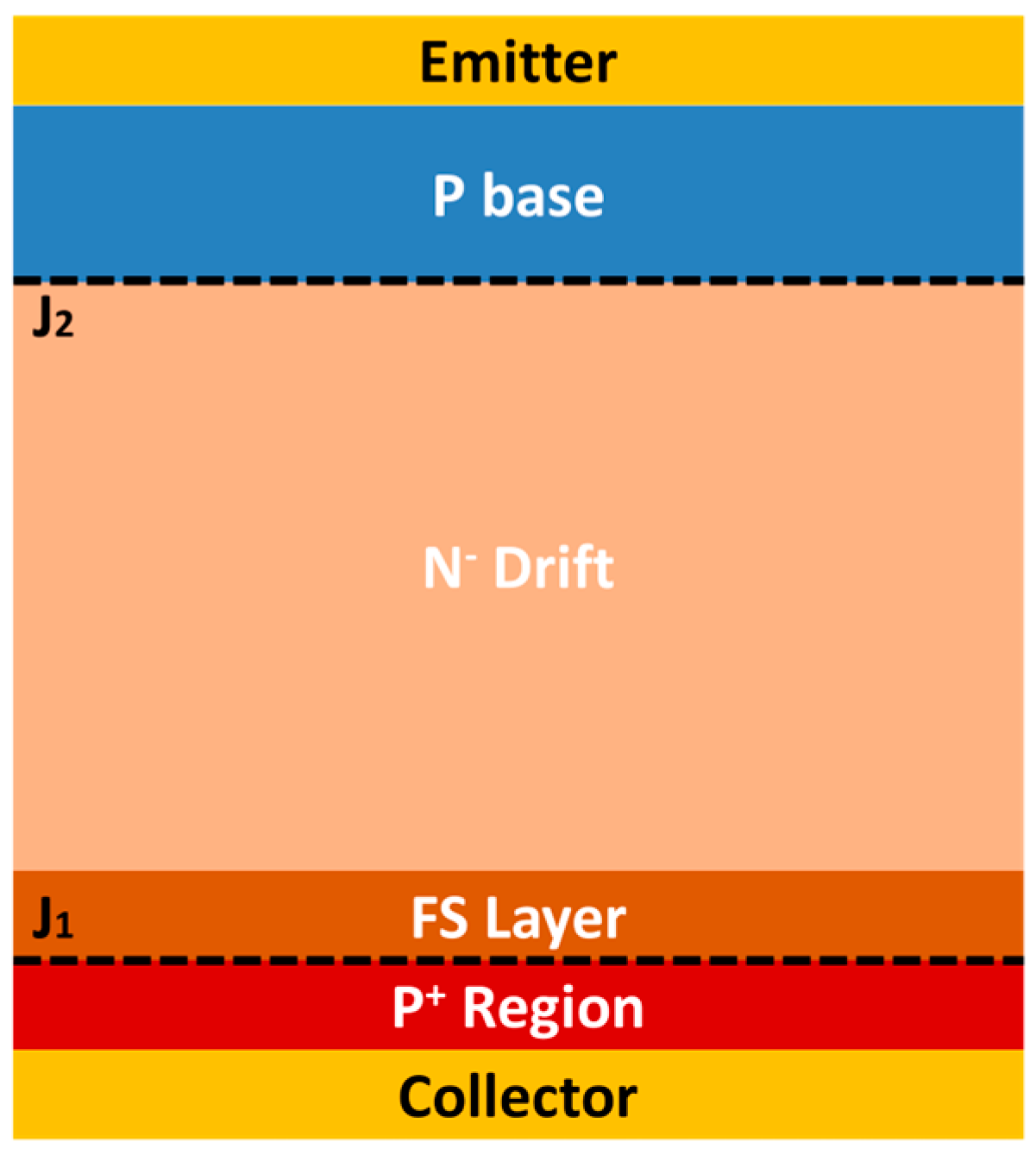



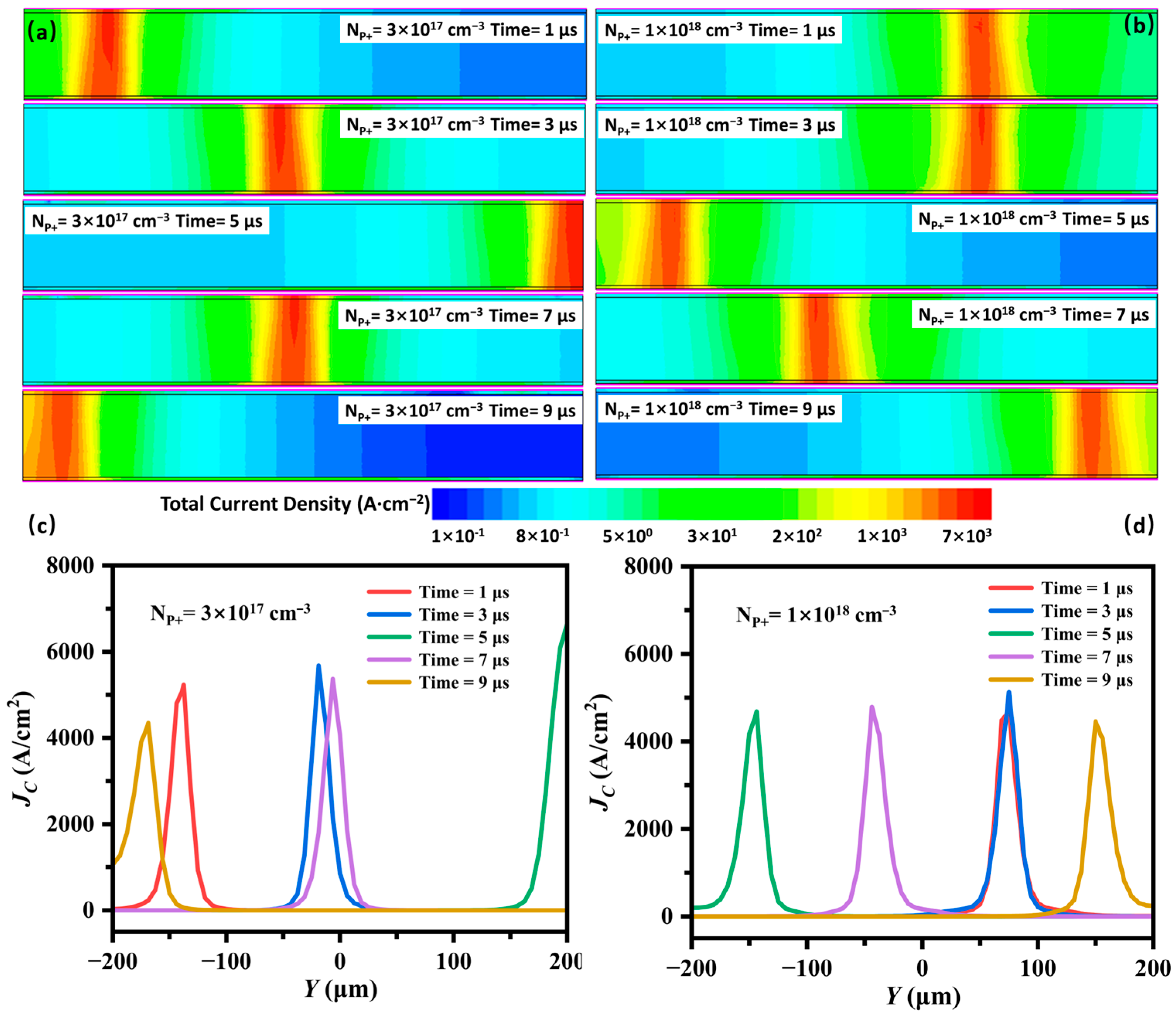
| Symbol | Structure Parameter | Value |
|---|---|---|
| TP+ | Collector P+ region depth | 1.0 μm |
| NP+ | Collector P+ region doping concentration | 3.0 × 1017 cm−3 |
| TFS | FS layer depth | 2.0 μm |
| NFS | FS layer doping concentration | 3.0 × 1016 cm−3 |
| Td | Drift thickness | 62.0 μm |
| Nd | Drift doping concentration | 1.0 × 1014 cm−3 |
| Tt | Gate trench depth | 5.0 μm |
| Wt | Gate trench width | 1.0 μm |
| Tox | Gate oxide thickness | 0.12 μm |
| TPbase | P base depth | 3.0 μm |
| LPbase | P base length | 1.0 μm |
| NPbase | P base doping concentration | 1.0 × 1017 cm−3 |
| TN+ | N+ depth | 0.3 μm |
| LN+ | N+ length | 0.5 μm |
| NN+ | N+ doping concentration | 1.0 × 1020 cm−3 |
| TEP+ | P+ depth | 0.3 μm |
| LEP+ | P+ length | 0.5 μm |
| NEP+ | P+ doping concentration | 1.0 × 1020 cm−3 |
Disclaimer/Publisher’s Note: The statements, opinions and data contained in all publications are solely those of the individual author(s) and contributor(s) and not of MDPI and/or the editor(s). MDPI and/or the editor(s) disclaim responsibility for any injury to people or property resulting from any ideas, methods, instructions or products referred to in the content. |
© 2024 by the authors. Licensee MDPI, Basel, Switzerland. This article is an open access article distributed under the terms and conditions of the Creative Commons Attribution (CC BY) license (https://creativecommons.org/licenses/by/4.0/).
Share and Cite
Zhang, J.; Luo, H.; Wu, H.; Zheng, B.; Chen, X.; Zhang, G.; French, P.; Wang, S. Effects of Current Filaments on IGBT Avalanche Robustness: A Simulation Study. Electronics 2024, 13, 2347. https://doi.org/10.3390/electronics13122347
Zhang J, Luo H, Wu H, Zheng B, Chen X, Zhang G, French P, Wang S. Effects of Current Filaments on IGBT Avalanche Robustness: A Simulation Study. Electronics. 2024; 13(12):2347. https://doi.org/10.3390/electronics13122347
Chicago/Turabian StyleZhang, Jingping, Houcai Luo, Huan Wu, Bofeng Zheng, Xianping Chen, Guoqi Zhang, Paddy French, and Shaogang Wang. 2024. "Effects of Current Filaments on IGBT Avalanche Robustness: A Simulation Study" Electronics 13, no. 12: 2347. https://doi.org/10.3390/electronics13122347






